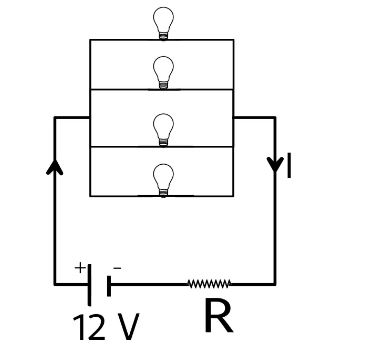Answer
327k+ views
Hint: Here the current value and the voltage value for the normal brightness of the bulb is given, so we can add up the current value of the current passing through each bulb to get the total current through the battery, as these bulbs are parallel to each so their current values get added. Since we have the current value and the voltage value is given, we can conclude that power is dissipated by each bulb.
Formulas used:
$P = VI$
Where $P$ is the power, $V$ is the voltage and $I$ is the current value.
$V = IR$
Where $V$ is the voltage, $I$ is the current and $R$ is the resistance value.
Complete step by step answer:

Here we have replaced each of the bulbs with a resistance value of $K$. Now we need $0.5A$ of the current through each of the bulb for normal brightness
So total current through the circuit for normal brightness is $ = 0.5 \times 4 = 2A$
The total voltage required for normal brightness $ = 1.5V$
Since the connections are in parallel, the voltage will be equal for all the bulbs.
Voltage value through the resistance $R$ is $ = 12 - 1.5 = 10.5V$
Now we have the voltage $10.5V$ left and the current through the resistance is $2A$. So, the maximum value of resistance is,
$R = \dfrac{V}{I} \\
\Rightarrow R = \dfrac{{10.5}}{2} \\
\Rightarrow R = \dfrac{{21}}{4}\Omega $
Now, power dissipated through resistance $R$ is $ = VI = 10.5 \times 2 = 21\,W$
And power dissipated through all the bulb $ = 4 \times \left( {1.5 \times 0.5} \right) = 3\,W$
So, the total value of power dissipated$ = 21 + 3 = 24\,W$
Therefore, the correct options are (B), (C) and (D).
Note: Now there is another way to determine the power is to find the resistance of each of the bulb and then we use the formula $\left( {P = {I^2}R} \right)$ where $I$ is the current and $R$ is the value of the resistance of each of the bulb. This process will give us the answer but this will be lengthy, and will take comparatively extra time.
Formulas used:
$P = VI$
Where $P$ is the power, $V$ is the voltage and $I$ is the current value.
$V = IR$
Where $V$ is the voltage, $I$ is the current and $R$ is the resistance value.
Complete step by step answer:

Here we have replaced each of the bulbs with a resistance value of $K$. Now we need $0.5A$ of the current through each of the bulb for normal brightness
So total current through the circuit for normal brightness is $ = 0.5 \times 4 = 2A$
The total voltage required for normal brightness $ = 1.5V$
Since the connections are in parallel, the voltage will be equal for all the bulbs.
Voltage value through the resistance $R$ is $ = 12 - 1.5 = 10.5V$
Now we have the voltage $10.5V$ left and the current through the resistance is $2A$. So, the maximum value of resistance is,
$R = \dfrac{V}{I} \\
\Rightarrow R = \dfrac{{10.5}}{2} \\
\Rightarrow R = \dfrac{{21}}{4}\Omega $
Now, power dissipated through resistance $R$ is $ = VI = 10.5 \times 2 = 21\,W$
And power dissipated through all the bulb $ = 4 \times \left( {1.5 \times 0.5} \right) = 3\,W$
So, the total value of power dissipated$ = 21 + 3 = 24\,W$
Therefore, the correct options are (B), (C) and (D).
Note: Now there is another way to determine the power is to find the resistance of each of the bulb and then we use the formula $\left( {P = {I^2}R} \right)$ where $I$ is the current and $R$ is the value of the resistance of each of the bulb. This process will give us the answer but this will be lengthy, and will take comparatively extra time.
Recently Updated Pages
Mark and label the given geoinformation on the outline class 11 social science CBSE

When people say No pun intended what does that mea class 8 english CBSE

Name the states which share their boundary with Indias class 9 social science CBSE

Give an account of the Northern Plains of India class 9 social science CBSE

Change the following sentences into negative and interrogative class 10 english CBSE

Advantages and disadvantages of science

Trending doubts
Difference between Prokaryotic cell and Eukaryotic class 11 biology CBSE

Fill the blanks with the suitable prepositions 1 The class 9 english CBSE

Differentiate between homogeneous and heterogeneous class 12 chemistry CBSE

Difference Between Plant Cell and Animal Cell

Which are the Top 10 Largest Countries of the World?

10 examples of evaporation in daily life with explanations

Give 10 examples for herbs , shrubs , climbers , creepers

Write a letter to the principal requesting him to grant class 10 english CBSE

Change the following sentences into negative and interrogative class 10 english CBSE




